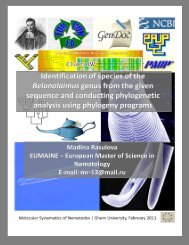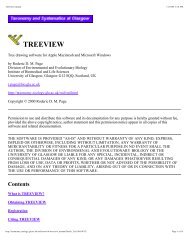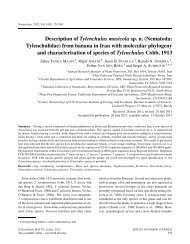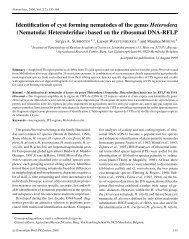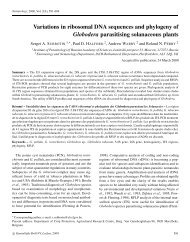Morphological and molecular characterisation of Californian species ...
Morphological and molecular characterisation of Californian species ...
Morphological and molecular characterisation of Californian species ...
You also want an ePaper? Increase the reach of your titles
YUMPU automatically turns print PDFs into web optimized ePapers that Google loves.
Studies on Metaporcelaimus<br />
iii) higher <strong>and</strong> narrower lip region; iv) generally longer<br />
odontostyle aperture (vs up to one-half <strong>of</strong> odontostyle<br />
length); v) comparatively anterior position <strong>of</strong> S 1 N 1 (closer<br />
to DN than to S 1 N 2 vs closer to S 1 N 2 than to DN); vi) the<br />
shape (conical vs conoid to rounded) <strong>and</strong> length (longer vs<br />
always shorter than anal body diam.) <strong>of</strong> the tail; vii) much<br />
more frequent presence <strong>of</strong> males; <strong>and</strong> viii) the always<br />
slender (dorylaimoid) spicules (vs <strong>of</strong>ten strongly swollen<br />
with wide lumen). However, the same author suggested<br />
that further studies would be necessary to refine the definition<br />
<strong>of</strong> both genera. In a subsequent paper, Andrássy<br />
(2009) listed 14 <strong>species</strong> under Metaporcelaimus.<br />
COMPARATIVE MORPHOLOGICAL ANALYSIS OF<br />
Metaporcelaimus AND Aporcelaimellus<br />
The eight tentative differences between these two genera,<br />
as proposed by Andrássy (2001, see previous paragraph)<br />
are analysed here. The available information about<br />
these characters for the 12 valid <strong>species</strong> classified under<br />
Metaporcelaimus by Andrássy (2009) were compiled,<br />
analysed <strong>and</strong> compared with Aporcelaimellus <strong>species</strong><br />
(two <strong>species</strong> also listed under Metaporcelaimus by Andrássy<br />
(2001) were not considered: M. angusticollis Andrássy,<br />
2001, regarded as <strong>species</strong> inquirenda by Álvarez-<br />
Ortega & Peña-Santiago (2010a); <strong>and</strong> M. simplex (Thorne<br />
& Swanger, 1936) Andrássy, 2001, transferred to Aporcella<br />
Andrássy, 2002a by Álvarez-Ortega et al. (2013)).<br />
Body form<br />
Metaporcelaimus: As shown by the means <strong>of</strong> ratio a,<br />
this feature ranges from 26 to 55, <strong>of</strong>ten varying between<br />
30 to 40. Only two <strong>species</strong>, M. adoxus (Tjepkema, Ferris<br />
& Ferris, 1971) Andrássy, 2001 <strong>and</strong> M. mombucae<br />
Lordello, 1965, may be under 30, while eight <strong>of</strong> them may<br />
exceed 40: M. capitatus (Thorne & Swanger, 1936) Andrássy,<br />
2001, M. efficiens (Thorne & Swanger, 1936) Andrássy,<br />
2001, M. invisus (Tjepkema, Ferris & Ferris, 1971)<br />
Andrássy, 2001, M. labiatus (de Man, 1880) Andrássy,<br />
2001, M. mombucae, M. oceanicus Andrássy, 2001, M.<br />
romanicus (Popovici, 1978) Andrássy, 2001 <strong>and</strong> M. sublabiatus<br />
(Thorne & Swanger, 1936) Andrássy, 2001. Although<br />
an important variability is observed, Metaporcelaimus<br />
<strong>species</strong> are slender (a = 30-40) to very slender (a ><br />
40) dorylaimid nematodes.<br />
Aporcelaimellus: ratio a ranges from 14 (a = 14-<br />
18 in A. insularis Andrássy, 2004) to 49 (a = 42-49<br />
in A. parangalitzi Ilieva & Eliava, 1993, <strong>of</strong>ten varying<br />
from 20-40, since only six <strong>species</strong> (A. chauhani Baqri &<br />
Khera, 1975, A. duhouxi (Altherr, 1963) Baqri & Khera,<br />
1975, A. insularis, A. krygeri (Ditlevsen, 1928) Heyns,<br />
1965, A. malagasi Heyns, 1996, <strong>and</strong> A. saprophilus<br />
Gagarin & Gusakov, 2001) may be under 20, while<br />
a low percentage (10%, 5 out <strong>of</strong> 49) may exceed 40<br />
(A. conoidus Thorne, 1974, A. macropunctatus (Heyns,<br />
1967) Jiménez-Guirado, 1994, A. micropunctatus Botha<br />
& Heyns, 1990, A. parangalitzi <strong>and</strong> A. raniensis Altherr,<br />
1968). Aporcelaimellus <strong>species</strong> hence display a large<br />
variability concerning this feature, <strong>of</strong>ten being stout (a <<br />
20), moderately slender (a = 20-30) or slender nematodes.<br />
Metaporcelaimus <strong>species</strong> are therefore in general more<br />
slender than those <strong>of</strong> Aporcelaimellus, but both genera<br />
show a large variability affecting ratio a <strong>and</strong>, most<br />
important, display a wide overlap. As currently defined,<br />
these taxa cannot be separated on the base <strong>of</strong> their body<br />
form.<br />
Nature <strong>of</strong> cuticle<br />
Metaporcelaimus: This character has not received much<br />
attention in the <strong>species</strong> descriptions <strong>and</strong> hence the literature<br />
does not provide useful information for comparative<br />
purposes. Nevertheless, our observations on a few <strong>species</strong><br />
(see M. capitatus <strong>and</strong> M. romanicus in Álvarez-Ortega<br />
& Peña-Santiago, 2010a, b, respectively, <strong>and</strong> <strong>Californian</strong><br />
<strong>species</strong> described above) reveals that it is typical dorylaimoid,<br />
that is consisting <strong>of</strong> a thin outer layer <strong>and</strong> a much<br />
thicker (especially at the caudal region) inner layer, lacking<br />
any special differentiation.<br />
Aporcelaimellus: The typical representative <strong>of</strong> this<br />
genus, for instance the cosmopolitan <strong>and</strong> type <strong>species</strong>, A.<br />
obtusicaudatus (Bastian, 1865) Altherr, 1968, as well as<br />
many rounded-tailed forms, are characterised by having<br />
a ‘three-layered cuticle’ (Tjepkema et al., 1971; Baqri<br />
& Khera, 1975; De Ley et al., 1993; Andrássy, 2002b)<br />
which is more perceptible in the caudal region <strong>and</strong> which<br />
consists <strong>of</strong>: i) a thin outer layer; ii) an intermediate layer,<br />
which is quite thin, but <strong>of</strong>ten becoming thicker at the<br />
tail terminus <strong>and</strong> forming a more or less (usually poorly)<br />
developed hyaline portion; <strong>and</strong> iii) a thick inner layer,<br />
especially dense or compact, <strong>and</strong> with different refraction<br />
when compared to the other layers. However, this pattern<br />
is not perceptible in conical-tailed forms (for instance, see<br />
several <strong>species</strong> recently re-described by Álvarez-Ortega<br />
& Peña-Santiago, 2010a), in which the nature <strong>of</strong> cuticle is<br />
completely comparable to that found in Metaporcelaimus.<br />
Aporcelaimellus <strong>species</strong> can therefore be divided in two<br />
groups according to their cuticle nature: rounded- <strong>and</strong><br />
rounded conoid-tailed forms show a three-layered pattern<br />
while conical tailed forms display the typical dorylaimoid,<br />
two-layered pattern. Because Metaporcelaimus<br />
Vol. 00(0), 2012 13



